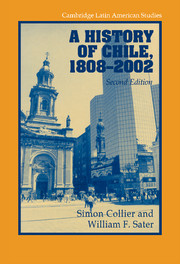Book contents
- Frontmatter
- Contents
- List of maps
- Preface to the Second Edition
- A note on geography
- CAMBRIDGE LATIN AMERICAN STUDIES
- PART I Birth of a nation-state, 1800s–1830s
- PART II The rise of a republic, 1830s–1880s
- PART III The nitrate era, 1880s–1930s
- 7 The Parliamentary period, 1882–1920
- 8 The Lion and the mule, 1920–38
- PART IV Industrial advance and the dawn of mass politics, 1930s–1960s
- PART V Democracy and dictatorship, 1960s–2000s
- Glossary of Spanish terms
- Initials and acronyms
- Further reading
- Index
7 - The Parliamentary period, 1882–1920
Published online by Cambridge University Press: 05 June 2012
- Frontmatter
- Contents
- List of maps
- Preface to the Second Edition
- A note on geography
- CAMBRIDGE LATIN AMERICAN STUDIES
- PART I Birth of a nation-state, 1800s–1830s
- PART II The rise of a republic, 1830s–1880s
- PART III The nitrate era, 1880s–1930s
- 7 The Parliamentary period, 1882–1920
- 8 The Lion and the mule, 1920–38
- PART IV Industrial advance and the dawn of mass politics, 1930s–1960s
- PART V Democracy and dictatorship, 1960s–2000s
- Glossary of Spanish terms
- Initials and acronyms
- Further reading
- Index
Summary
Chile … is corroded to the heart by the poison of nitrate. Nitrate has been for Chile like the famous wine of the Borgias: among the grains of the fertile nitrate is hidden the poison that enervates, rots and kils….
– El Diario. Buenos Aires, quoted in El Mercurio de Valparaiso. December 29, 1907The elements that make up the Alliance – are they homogeneous?
– Ramón Barros Luco (1918)Santa María and Balmaceda
President Santa María, in addition to having to deal with the end of the War of the Pacific, was also obliged to contend with a political scene that was (as we saw earlier on) fast losing the coherence it had earlier enjoyed. Congressmen were increasingly attracted by “parliamentary” ideas: the diminution of executive power, congressional control of the cabinet, and free elections. Santa María, whatever he may previously have done or said, wished to uphold presidential power. He was able to do so only by providing the factions of his undisciplined Liberal party with a common enemy, and by ruthless electoral intervention, amply in evidence at the polls in 1882, which were marked by both violence and bribery – “for every independent voter,” claimed the newspaper La Época, “there are two or more who sell their vote.” The president himself was hostile to what he termed “medieval prejudices,” and was eager to reduce the still powerful role of the Church in Chilean life.
- Type
- Chapter
- Information
- A History of Chile, 1808–2002 , pp. 149 - 201Publisher: Cambridge University PressPrint publication year: 2004



